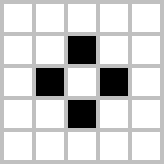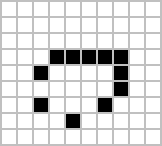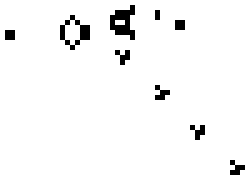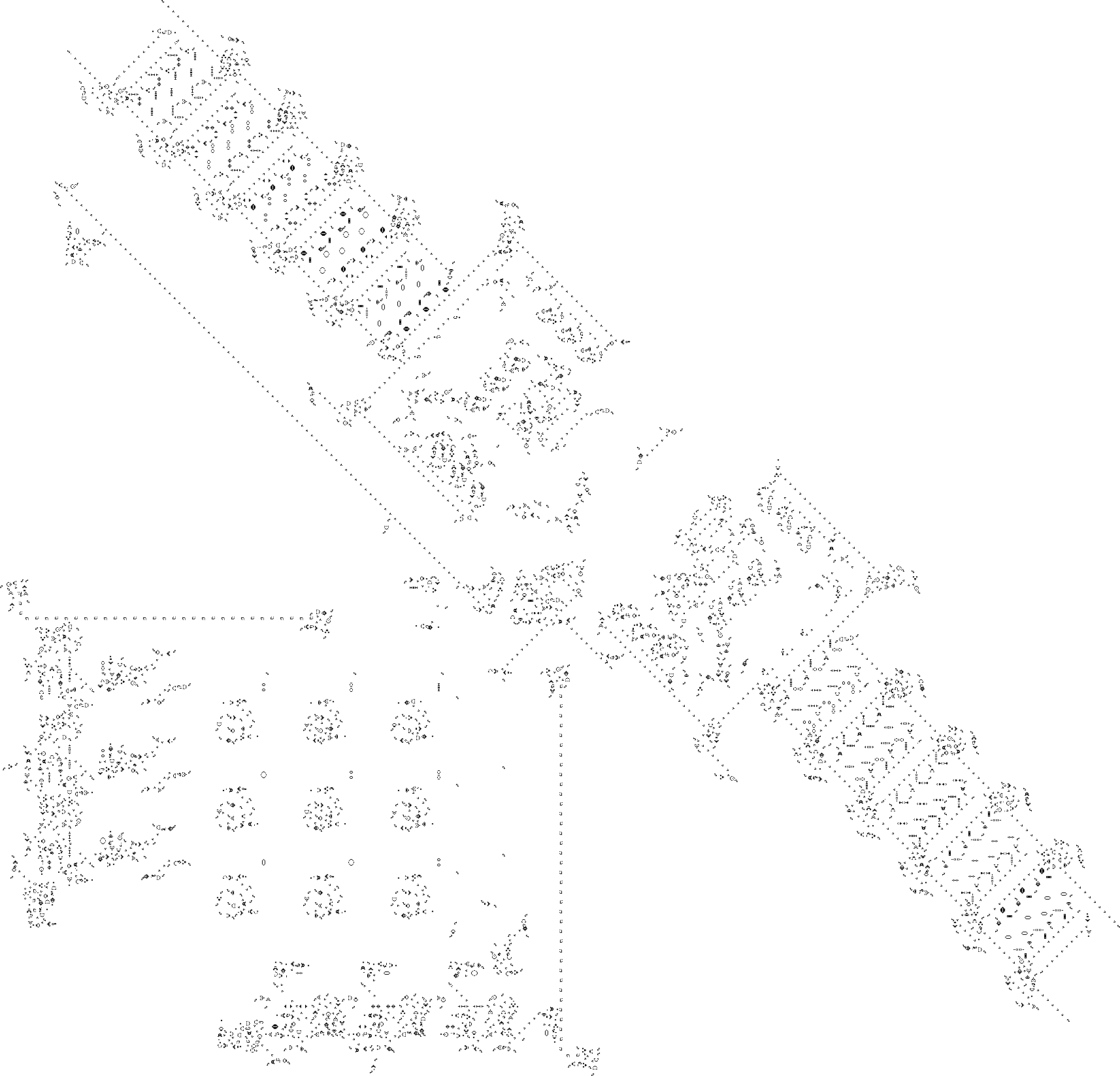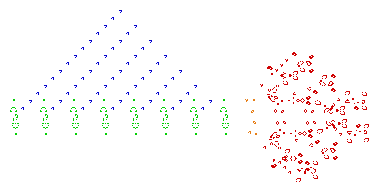Towards general CA Study: The Game of Life
Towards general CA Study: The Game of Life
The game of life is a very simple set of rules (can't be much simpler, in fact) that can still exhibit the same richness of behaviors as Von Neumann's CA, with much more simplicity
The game of life is a very simple set of rules (can't be much simpler, in fact) that can still exhibit the same richness of behaviors as Von Neumann's CA, with much more simplicity
The rules are much simpler (and they can't get much simpler given their definition)
•
The rules are much simpler (and they can't get much simpler given their definition)
It is much easier, starting from random initial configurations, to get some interesting behaviors, facilitating the discovery
•
It is much easier, starting from random initial configurations, to get some interesting behaviors, facilitating the discovery
There has been intense research (mostly by hobbyists) to build incredibly sophisticated things with the game of life
•
There has been intense research (mostly by hobbyists) to build incredibly sophisticated things with the game of life
Due to the limited number of states, building Turing machines and self-replicators requires many more cells
•
Due to the limited number of states, building Turing machines and self-replicators requires many more cells
Though neither is particularly designed with robustness in mind, the game of life is even more 'brittle' than the Von Neumann CA, in that very many perturbations in a 'living' region will lead to a catastrophic large-scale failure of the 'creatures' involved
•
Though neither is particularly designed with robustness in mind, the game of life is even more 'brittle' than the Von Neumann CA, in that very many perturbations in a 'living' region will lead to a catastrophic large-scale failure of the 'creatures' involved
There are two states $0$ (quiescent/dead) and $1$ (excited/alive)
There are two states
0 (quiescent/dead) and
1 (excited/alive)
The evolution is determined by the eight neighbors, it is a totalistic rule (the next state depends on the sum of the eight neighbors)
The evolution is determined by the eight neighbors, it is a totalistic rule (the next state depends on the sum of the eight neighbors)
Cells with two live neighbors stay the same
•
Cells with two live neighbors stay the same
Cells with three live neighbors will live
•
Cells with three live neighbors will live
Cells with one or more than three neighbors die
•
Cells with one or more than three neighbors die
Some Interesting Zoology
Some Interesting Zoology
Gliders & Spaceships
Gliders & Spaceships
Static Patterns
Static Patterns
Turing Machines
Turing Machines
Gardens of Eden, Orphans, Twins, Parents
Gardens of Eden, Orphans, Twins, Parents
Can we reverse the Game of Life dynamics?
Can we reverse the Game of Life dynamics?
Quite obviously the answer is no in general, because the dynamics is not injective
Quite obviously the answer is no in general, because the dynamics is not injective
Are there patterns that don't have a pre-image?
Are there patterns that don't have a pre-image?
Moore Theorem
Moore Theorem
Twins imply orphans
Twins imply orphans
Intuitively, the answer is 'yes' because of the obvious result that if a function on a finite set
Intuitively, the answer is 'yes' because of the obvious result that if a function on a finite set
It is an interesting example of results about cellular automata, and it is useful to think about how to prove them
It is an interesting example of results about cellular automata, and it is useful to think about how to prove them
Myhill Theorem
Myhill Theorem
Orphans imply twins
Orphans imply twins
Orphans and Gardens of Eden
Orphans and Gardens of Eden
These are called 'Garden of Eden'
These are called 'Garden of Eden'
Naive (but somehow correct) idea
Naive (but somehow correct) idea
For functions $f:S\to S$, if $S$ is a finite set, then if $f$ is not injective (that would be easy to prove: just find two elements with the same image), then $f$ is not surjective... it is an equivalence in fact
For functions
f:S→S, if
S is a finite set, then if
f is not injective (that would be easy to prove: just find two elements with the same image), then
f is not surjective... it is an equivalence in fact
The (small) problem
The (small) problem
Coarse-Graining of Game of Life CA
Coarse-Graining of Game of Life CA
An Interesting Exercise
An Interesting Exercise
Prove that the Game of Life cannot be obtained by coarse-graining (some rule saying that at some scale we declare a cell to be 1 or 0) of a reversible (there is another cellular automaton that can be run to go back in time) cellular automaton in two dimensions
•
Prove that the Game of Life cannot be obtained by coarse-graining (some rule saying that at some scale we declare a cell to be 1 or 0) of a reversible (there is another cellular automaton that can be run to go back in time) cellular automaton in two dimensions
The space of configurations of a cellular automaton is not finite, so we should be careful (obviously if $S$ is infinite in general, nothing can be said)
The space of configurations of a cellular automaton is not finite, so we should be careful (obviously if
S is infinite in general, nothing can be said)
The dynamics is almost about finite sets, though, in that to determine the state of a region of size $n\times n$, we just need to know the state of the region $(n+2)\times(n+2)$ at the previous step (we need to add a layer of thickness 1 around the box, corresponding to the range of the influence for the game of life)
The dynamics is almost about finite sets, though, in that to determine the state of a region of size
n×n, we just need to know the state of the region
(n+2)×(n+2) at the previous step (we need to add a layer of thickness 1 around the box, corresponding to the range of the influence for the game of life)
So, the problem is what could happen with that extra layer
So, the problem is what could happen with that extra layer
So, instead of looking at 'lack of injectivity', we will introduce the notion of _twins_, which is two patterns that will get mapped to the same thing _regardless of what we put on the boundary_
So, instead of looking at 'lack of injectivity', we will introduce the notion of twins, which is two patterns that will get mapped to the same thing regardless of what we put on the boundary
And instead of 'lack of surjectivity', we will speak of _orphans_, which are patterns that cannot be obtained by a step of the dynamics, _regardless of what we put on the boundary_
And instead of 'lack of surjectivity', we will speak of orphans, which are patterns that cannot be obtained by a step of the dynamics, regardless of what we put on the boundary
Let's work concretely with a concrete example relevant to the game of life (numbers can be changed, to suit any situation)
Let's work concretely with a concrete example relevant to the game of life (numbers can be changed, to suit any situation)
There are twins for a $5\times5$ configuration: if we take all-0s and 1-in-center-surrounded-by-0s, then they have the same image, no matter what we put outside
There are twins for a
5×5 configuration: if we take all-0s and 1-in-center-surrounded-by-0s, then they have the same image, no matter what we put outside
Now, if we create a very large pattern of say $5N\times 5N$, made by $N\times N$ patterns of $5\times 5$, then how many possible images does it have?
Now, if we create a very large pattern of say
5N×5N, made by
N×N patterns of
5×5, then how many possible images does it have?
For each $5\times5$ pattern, there are at least two configurations that get mapped to the same thing, we have $2^{N^2}$ patterns that get mapped to the same thing... is that a bad thing?
For each
5×5 pattern, there are at least two configurations that get mapped to the same thing, we have
2N2 patterns that get mapped to the same thing... is that a bad thing?
We can say that since the twins are mapped to the same configurations, we can just get rid of one, so the number of possible images under the dynamics is at most $(2^{25}-1)^{N^2} 2^{4N+4}$, where the $2^{4N+4}$ is the number of possible boundary conditions
We can say that since the twins are mapped to the same configurations, we can just get rid of one, so the number of possible images under the dynamics is at most
(225−1)N224N+4, where the
24N+4 is the number of possible boundary conditions
Prove that there are reversible 2d cellular automata that are Turing-complete: they can run a Turing machine with a tape, etc.
•
Prove that there are reversible 2d cellular automata that are Turing-complete: they can run a Turing machine with a tape, etc.
But for $N$ large enough, we have that this number $(2^{25}-1)^{N^2} 2^{4N+4}$ is smaller than $(2^{25})^{N^2}$ (the set of possible patterns), since $(2^{25}-1)/(2^{25})<1$ and $\alpha^{N^2}\beta^{4N}$ for $\alpha<1$ and $\beta>1$ will tend to zero
But for
N large enough, we have that this number
(225−1)N224N+4 is smaller than
(225)N2 (the set of possible patterns), since
(225−1)/(225)<1 and
αN2β4N for
α<1 and
β>1 will tend to zero
So, there are patterns that are not in the image, and these are orphans
So, there are patterns that are not in the image, and these are orphans
The proof is somehow similar: if there are patterns of size $k\times k$ that are not reached no matter the boundary conditions (say), then for large enough patterns made of $M\times M$ copies of such patterns, we must have some pairs of patterns that get mapped to the same states, no matter the boundary conditions
The proof is somehow similar: if there are patterns of size
k×k that are not reached no matter the boundary conditions (say), then for large enough patterns made of
M×M copies of such patterns, we must have some pairs of patterns that get mapped to the same states, no matter the boundary conditions
(Part of a paper with Bara Hudcova and Jordan Cotler in writing...)
(Part of a paper with Bara Hudcova and Jordan Cotler in writing...)
Deduce that Turing-complete does not imply 'coarse-graining universal'
•
Deduce that Turing-complete does not imply 'coarse-graining universal'
Obviously, any configuration that contains a pattern is a Garden of Eden
Obviously, any configuration that contains a pattern is a Garden of Eden
The converse, that if there is a Garden of Eden configuration, then there must be orphan patterns, is a bit less obvious, but not very difficult
The converse, that if there is a Garden of Eden configuration, then there must be orphan patterns, is a bit less obvious, but not very difficult
.
